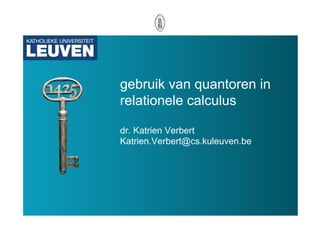
gebruik van quantoren in relationele calculus
- 1. gebruik van quantoren in relationele calculus dr. Katrien Verbert Katrien.Verbert@cs.kuleuven.be
- 2. tupel relationele calculus • Basisvorm: {t | formule(t)} – t is een tupelvariabele en formule(t) een formule waarin tupelvariable t voorkomt. • Resultaat: – Verzameling van alle tupels t waarvoor formule(t) waar is. • Formule bestaat uit: – atomen + logische connectoren + quantificatoren 2
- 3. voorbeeld • { t | EMPLOYEE(t) and t.SALARY > 50000 } 3
- 4. formule • wordt uitgedrukt in predicatenlogica • maakt gebruik van – variabelen – constanten – vergelijkingsoperatoren =≠<>≥≤ – logische connectoren ¬∧∨⇔⇒ – quantificatie van variabelen: ∃ (er bestaat), ∀ (voor alle) 4
- 5. voorbeeld connector constante • { t | EMPLOYEE(t) and t.SALARY > 50000 } vergelijkingsoperator variabele 5
- 6. quantoren • Existentiële quantor: ∃ (er bestaat) • Universele quantor: ∀ (voor alle) • (∃t)(formule(t)) – er bestaat een tupel t die aan de conditie voldoet – bv. (∃t)(EMPLOYEE(t) and t.fname=‘John’) • (∀t)(formule(t)) – alle tuples in het universum voldoen aan de conditie 6
- 7. • Q_1 – Geef naam en adres van alle werknemers die voor het 'Research' departement werken { t.Fname, t.Lname, t.Address | EMPLOYEE(t) AND (∃d) (DEPARTMENT(d) AND d.Dname = 'Research’ AND d.Number = t.Dno) } existentiële quantor: moet waar zijn voor tenminste één tuple we vragen werknemers op waarvoor er een gerelateerd tupel in de departement tabel bestaat met als naam ‘Research’
- 8. gebruik van universele quantoren • (∀x) (P(x)) – waar als P(x) waar is voor elke x van het universum – bv. (∀x) (x.color = “Rood”) – betekent dat alles wat bestaat rood is • logische implicatie – (∀x) (Boot(x) ⇒ (x.color = “Rood”)) – (∀x) IF Boot(x) THEN (x.color = “Rood”) – Als x een boot is, dan moet de kleur rood zijn 8
- 9. gebruik van universele quantoren • ⇒ is een logische implicatie – a ⇒ b betekent dat als a waar is, ook b waar moet zijn – a ⇒ b is hetzelfde als ¬a ∨ b • (∀x) (x.dnum=5 ⇒ F2) • (∀x) IF x.dnum=5 THEN F2 • (∀x) (not (x.dnum=5) or F2) – x.dnum=5: F2 moet waar zijn 9
- 10. gebruik van universele quantoren • (∀x) (Boot(x) ⇒ (x.color = ‘Rood’)) • ⇒ is een logische implicatie – als x een boot is, dan moet de kleur rood zijn • (∀x) (¬Boot(x) ∨ x.color = ‘Rood’) – X is geen boot: conditie is waar – X is een boot: x.color=‘Rood’ moet waar zijn 10
- 11. – Q_3: Geef de namen van de werknemers die aan alle projecten werken { e.Lname, e.Fname | EMPLOYEE(e) AND ( (∀x) ( NOT (PROJECT(x)) OR ( (∃w) ( WORKS_ON(w) AND w.Essn = e.Ssn AND x.Pnumber = w.Pno ) ) ) ) } In woorden: als x een project is, dan moet er een overeenkomsUg tupel in de works_on tabel bestaan. 11
- 12. { e.Lname, e.Fname | EMPLOYEE(e) AND ( (∀x) ( NOT (PROJECT(x)) OR ( (∃w) ( WORKS_ON(w) AND w.Essn = e.Ssn AND x.Pnumber = w.Pno ) ) ) ) } – ( ∀ x ) ( F ) : • moet voldaan zijn voor alle tuples in het universum die aan x kunnen worden toegekend – daarom: • ( ∀ x ) ( not PROJECT ( x ) ) • alle tupels die niet tot PROJECT behoren uitsluiten van verdere selectievoorwaarde – verder moet dus gelden voor een employee e dat hij werkt op elk project dat niet uitgesloten werd 12
- 13. • Q_6 – Geef de namen van alle werknemers zonder personen ten laste: {e.Fname, e.Lname | EMPLOYEE(e) AND ( (∀ d) ( NOT (DEPENDENT(d)) OR NOT (e.Ssn = d.Essn) ) ) } 13
